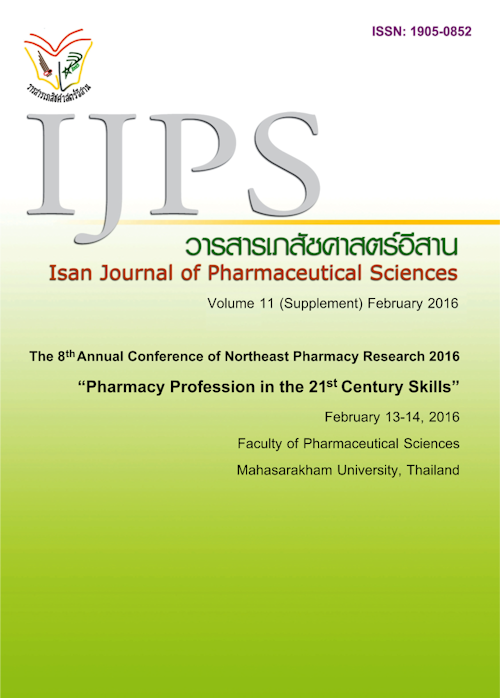Level of Understanding of Pictogram in Undergraduate Students in Humanities and Social Sciences; A Survey Study
Main Article Content
Abstract
Introduction: Pictograms were widely used in various countries such as USA, India and South Africa for communication of health information; because there are no limitations on language and these also increase patient’s memory than text labeling. However, the Universal Pictograms developed by USP-DI had limitations to interpret the image in each population group and there were no study about understanding and pictogram in Humanities and Social Sciences students. This study aimed to explore the understanding of the USP-DI pictograms, the Medication Use Literacy Test score (MULT) in Humanities and Social Sciences students, Mahasarakham University. Methods: This study was a survey study by street survey on various locations. The participants from different faculties completed questionnaires by themselves (self-administration) between August 2014 and April 2015. Moreover, the study was examined the relationship between different factors and understanding of pictograms score. Results: A total of 364 participants, the majority of them were female, first year students, and study in faculty of Accountancy and Management. The majority of participants (88.2%) had MULT score in high level (MULT score > 8), the 12.91% of them understood the pictograms with the total score over 85 percent. With regarding to factors affecting the understanding of pictograms score, the participants with underlying diseases and high MULT score showed a high correlation with a high level of understanding of the pictogram (p<0.05). Conclusion: Even though humanities and social sciences students had high level of MULT score, they had low score of understanding in pictogram. Factors affecting the understanding in pictogram were underlying diseases and MULT score.
Article Details
In the case that some parts are used by others The author must Confirm that obtaining permission to use some of the original authors. And must attach evidence That the permission has been included
References
Banstola A. Awareness of pictograms among the undergraduate pharmacy students in a pharmacy college in Karnataka India: A preliminary study. International Journal of pharmacy teaching & practice 2013; 4(1): 442-446.
Chaijinda K, Nilaward K, Chuamanochan P, Awiphan R. Development and evaluation of pictorial labeling system for Northern Thai patients with low literate skills. PhD thesis. Chiang Mai University.2007
Chan AH, Chan KW. Effects of prospective-user factors and sign design features on guessability of pharmaceutical pictograms. Patient Educ Couns2013; 90(2):268-75
Dowse R, Ehlers MS. The evaluation of pharmaceutical pictograms in a low-literate South African population. Patient Educ Couns 2001; 45(2): 87-99.
Micromedex Inc. Advice for the patient drug information in lay language. In; United states pharmacopoeia dispensing information volume II. 20thedition. 2000: 1617-26.
Saramunee K. General public views on community pharmacy services in public health school of pharmacy and biomolecular science, LJMU. 2013.
Sharf SI, Abdulla M, Yousif A, Mohamed D. Interpretation of pharmaceutical pictograms by pharmacy and non-pharmacy university students. Pharmacology & Pharmacy 2014; 5: 821-827.
Stison GV. Obeying doctor’s order: A view from the other side. Social Science & Medicine1974; 8: 97-104.


